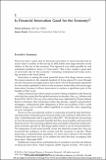| dc.contributor.author | Johnson, Simon | |
| dc.contributor.author | Kwak, James | |
| dc.date.accessioned | 2019-03-08T17:23:30Z | |
| dc.date.available | 2019-03-08T17:23:30Z | |
| dc.date.issued | 2012-01 | |
| dc.identifier.issn | 1531-3468 | |
| dc.identifier.issn | 1537-2618 | |
| dc.identifier.uri | http://hdl.handle.net/1721.1/120836 | |
| dc.description.abstract | There has been a great deal of financial innovation in recent decades but its social value is unclear. In the run-up to 2008, banks took large amounts of risk relative to the size of the economy. This approach was made possible by and sometimes justified in terms of "innovation." But it also created a great deal of downside risk for the economy-including widespread job losses and a big increase in the fiscal deficit. Innovation is among the most powerful forces that shape human society. The improvements in the material standard of living enjoyed by most (though not all) Americans are largely due to innovation. One of the principal arguments for free-market capitalism is that it is the economic system that most encourages innovation, because it allows innovators to capture a significant part of the benefits of their work. Today, financial innovation stands accused of being complicit in the financial crisis that has created the first global recession in decades. (See, e.g., Johnson and Kwak 2010, 105-9). The very innovations that were celebrated by former Federal Reserve chairman Alan Greenspan earlier this decade-negative-amortization mortgages, collateralized debt obligations (CDOs) and synthetic CDOs, credit default swaps, and so forth-either amplified or caused the crisis, depending on your viewpoint. However, the conventional wisdom is coalescing around the idea that financial innovation is basically good, but just needs to be watched a little more carefully. As Ben Bernanke said in a speech in May 2007: "We should also always keep in view the enormous economic benefits that flow from a healthy and innovative financial sector. The increasing sophistication and depth of financial markets promote economic growth by allocating capital where it can be most productive. The dispersion of risk more broadly across the financial system has, thus far, increased the resilience of the system and the economy to shocks. When proposing or implementing regulation, we must seek to preserve the benefits of financial innovation even as we address the risks that may accompany that innovation" (Bernanke 2007). Intellectual conservatives and bankers have mounted a more fervent defense of financial innovation. Niall Ferguson (2009) argued recently, "We need to remember that much financial innovation over the past 30 years was economically beneficial, and not just to the fat cats of Wall Street." But where is the evidence? It may seem obvious that if innovation promotes economic growth, financial innovation must also promote economic growth. But that does not necessarily follow. To understand this, we need to think about what we mean by innovation and how recent-and likely future-financial innovations affect concentration and risk in our financial system. The benefits of recent financial innovations have frequently been overstated. And to the extent that these innovations have encouraged or facilitated a high degree of leverage among very big institutions-and more devastating spillovers in the event that a big bank or other highly leveraged firm fails-we need to reassess potential and realized costs and risks. | en_US |
| dc.publisher | University of Chicago Press | en_US |
| dc.relation.isversionof | http://dx.doi.org/10.1086/663153 | en_US |
| dc.rights | Article is made available in accordance with the publisher's policy and may be subject to US copyright law. Please refer to the publisher's site for terms of use. | en_US |
| dc.source | University of Chicago Press | en_US |
| dc.title | Is Financial Innovation Good for the Economy? | en_US |
| dc.type | Article | en_US |
| dc.identifier.citation | Johnson, Simon and James Kwak. “Is Financial Innovation Good for the Economy?” Innovation Policy and the Economy 12 (January 2012): 1–16 © 2012 National Bureau of Economic Research | en_US |
| dc.contributor.department | Sloan School of Management | en_US |
| dc.contributor.mitauthor | Johnson, Simon | |
| dc.relation.journal | Innovation Policy and the Economy | en_US |
| dc.eprint.version | Final published version | en_US |
| dc.type.uri | http://purl.org/eprint/type/JournalArticle | en_US |
| eprint.status | http://purl.org/eprint/status/PeerReviewed | en_US |
| dc.date.updated | 2019-02-14T17:12:27Z | |
| dspace.orderedauthors | Johnson, Simon; Kwak, James | en_US |
| dspace.embargo.terms | N | en_US |
| dc.identifier.orcid | https://orcid.org/0000-0002-3354-7155 | |
| mit.license | PUBLISHER_POLICY | en_US |
